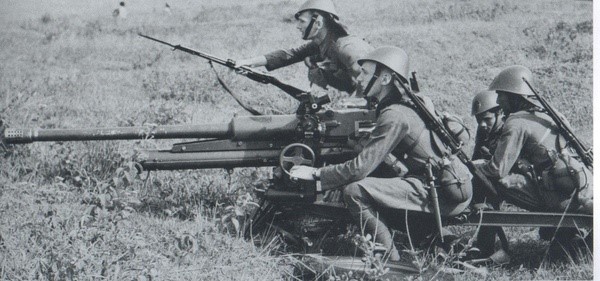
| Year | 1938 |
| Weapon Type | Light Anti-Tank Gun |
| Origin & Designer | Country & Design: Austrian/Böhler |
| Numbers Produced | 380 |
| Crew | 6 |
| Calibre | 47mm (47x227R) |
| Elevation | -10° to +52° |
| Traverse | 36° |
| Breech | Horizontal Sliding Wedge |
| Recoil | Hydropneumatic |
| Gun Sight | [@gun_sight] |
| Gun Mount | [@gun_mounts] |
| Carriage | Split Trail |
| Trailers | [@trailers] |
| Gun Shield | 3.2mm |
| Armoured Plate | [@armoured_plate] |
| Barrel Length | 1.680mm (L/39) |
| Overall Length | 3.21m |
| Width | 1.02m |
| Height | 0.88m |
| Weight | Weight in Traction: 345 kg Weight in Action: 310 kg |
| Round Weight | AP: 3.56 kg HE: 5.46 kg |
| Muzzle Velocity | AP: 660 m/s HE: 350 m/s |
| Feed | [@feed] |
| Magazine Capacity | [@magazine_capacity] |
| Practical Rate of Fire | [@practical_rate_of_fire] |
| Rate of Fire | 15 r.p.m. |
| Maximum Rate of Fire | [@maximum_rate_of_fire] |
| Maximum Ceiling | [@maximum_ceiling] |
| Maximum Ground Range | [@maximum_ground_range] |
| Maximum Range | 6000m |
| Armour Penetration | 35mm @ 500m @ 30° |
| Traction | Horse Drawn (One Horse) and Motorised (Fordson or DAF Truck) |
| Variants | [@variants] |
| Notes | The Van 4.7 was the main anti-tank weapon available to the Dutch army in 1940. The Dutch purchased 386 of these modern guns from the Austrian firm Böhler in 1936 and it was capable of firing HE shells as well as standard AP. They were in widespread use and most formations had six issued to an anti-tank company at regimental level. |